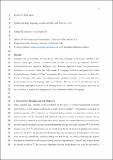Files in this item
Understanding language evolution : beyond Pan-centrism
Item metadata
| dc.contributor.author | Lameira, Adriano R. | |
| dc.contributor.author | Call, Josep | |
| dc.date.accessioned | 2021-01-29T00:36:36Z | |
| dc.date.available | 2021-01-29T00:36:36Z | |
| dc.date.issued | 2020-01-29 | |
| dc.identifier | 266265051 | |
| dc.identifier | d8a4b964-2481-4ddd-9d8b-e3cda52aaed1 | |
| dc.identifier | 85078767430 | |
| dc.identifier | 000509766400001 | |
| dc.identifier.citation | Lameira , A R & Call , J 2020 , ' Understanding language evolution : beyond Pan -centrism ' , BioEssays , vol. Early View , 1900102 . https://doi.org/10.1002/bies.201900102 | en |
| dc.identifier.issn | 0265-9247 | |
| dc.identifier.other | RIS: urn:2B0B7E25F3C141FFC69A3150002C44CB | |
| dc.identifier.other | ORCID: /0000-0002-8597-8336/work/68647896 | |
| dc.identifier.uri | https://hdl.handle.net/10023/21343 | |
| dc.description.abstract | Language does not fossilize but this does not mean that the language's evolutionary timeline is lost forever. Great apes provide a window back in time on our last prelinguistic ancestor's communication and cognition. Phylogeny and cladistics implicitly conjure Pan (chimpanzees, bonobos) as a superior (often the only) model for language evolution compared with earlier diverging lineages, Gorilla and Pongo (orangutans). Here, in reviewing the literature, it is shown that Pan do not surpass other great apes along genetic, cognitive, ecologic, or vocal traits that are putatively paramount for language onset and evolution. Instead, revived herein is the idea that only by abandoning single-species models and learning about the variation among great apes, there might be a chance to retrieve lost fragments of the evolutionary timeline of language. | |
| dc.format.extent | 381983 | |
| dc.language.iso | eng | |
| dc.relation.ispartof | BioEssays | en |
| dc.subject | Chimpanzees | en |
| dc.subject | Cognition | en |
| dc.subject | Communication | en |
| dc.subject | Great apes | en |
| dc.subject | Language evolution | en |
| dc.subject | BF Psychology | en |
| dc.subject | QL Zoology | en |
| dc.subject | T-NDAS | en |
| dc.subject.lcc | BF | en |
| dc.subject.lcc | QL | en |
| dc.title | Understanding language evolution : beyond Pan-centrism | en |
| dc.type | Journal article | en |
| dc.contributor.institution | University of St Andrews. School of Psychology and Neuroscience | en |
| dc.contributor.institution | University of St Andrews. Centre for Social Learning & Cognitive Evolution | en |
| dc.identifier.doi | 10.1002/bies.201900102 | |
| dc.description.status | Peer reviewed | en |
| dc.date.embargoedUntil | 2021-01-29 |
This item appears in the following Collection(s)
Items in the St Andrews Research Repository are protected by copyright, with all rights reserved, unless otherwise indicated.

